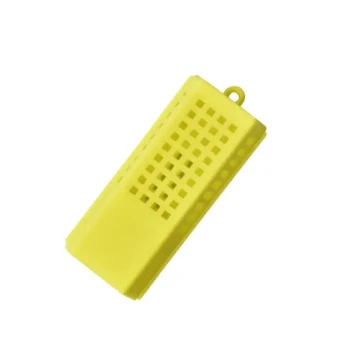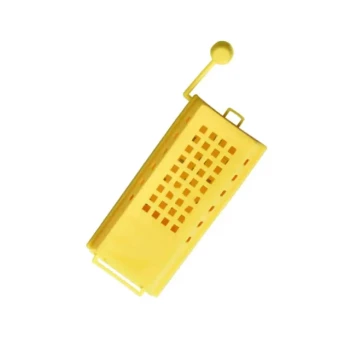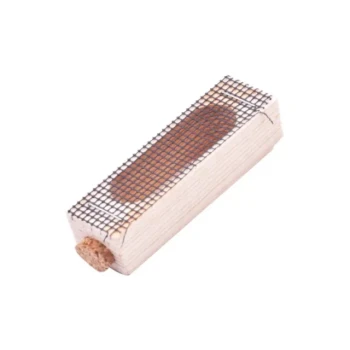The internationally recognized color code for marking queen bees is a five-year repeating cycle based on the last digit of the year. The system uses White for years ending in 1 or 6, Yellow for 2 or 7, Red for 3 or 8, Green for 4 or 9, and Blue for years ending in 5 or 0. This simple method allows a beekeeper to determine a queen's age with just a glance.
The primary purpose of the queen color code is not just identification, but efficient hive management. This simple visual cue instantly reveals the queen's age, which is the most critical factor in predicting a colony's productivity and health.

The Purpose Behind the Palette
Marking a queen bee with a specific color is a fundamental practice in modern beekeeping. It transforms a difficult task—finding one specific bee among tens of thousands—into a simple one and provides immediate, vital information.
Instant Identification
The most immediate benefit is the ability to locate the queen quickly. A small, bright dot on her thorax stands out against the backdrop of thousands of her offspring, saving significant time during hive inspections.
Age Tracking at a Glance
A queen's egg-laying prowess typically peaks in her second year and declines thereafter. Knowing her age allows a beekeeper to anticipate this decline and decide when to replace her to maintain a strong, productive colony. The color code makes age tracking effortless.
Detecting a Supersedure
Colonies will sometimes replace their queen on their own, a process called supersedure. If a beekeeper inspects a hive expecting to see a red-marked queen (from a year ending in 3 or 8) but instead finds an unmarked one, they know the original queen has been replaced. This is a critical observation for hive management.
The International Color Code System
This system is standardized globally, ensuring that a beekeeper anywhere can understand the age of a marked queen. The mnemonic "Will You Raise Good Bees?" can help remember the order: White, Yellow, Red, Green, Blue.
White (Years ending in 1 or 6)
Queens born or introduced in years like 2021 or 2026 are marked with a white dot.
Yellow (Years ending in 2 or 7)
Queens from years like 2022 or 2027 are marked with yellow.
Red (Years ending in 3 or 8)
Queens from years like 2023 or 2028 are marked with red.
Green (Years ending in 4 or 9)
Queens from years like 2024 or 2029 are marked with green.
Blue (Years ending in 5 or 0)
Queens from years like 2025 or 2020 are marked with blue.
Understanding the Trade-offs
While marking is the industry standard, it's a deliberate action with its own set of considerations. Understanding these ensures you approach the task with a complete perspective.
The Risk of Handling the Queen
The process of catching and marking a queen, while routine for experienced keepers, carries a small but real risk of damaging her. This is why a steady hand and confidence are crucial.
The "Do Nothing" Approach
Some beekeepers choose not to mark their queens. This avoids any risk of injury but makes finding the queen significantly more time-consuming and makes it impossible to know her age without meticulous written records.
When the System is Imperfect
Occasionally, you may purchase a queen from a supplier that was raised late in the previous year but marked with that year's color. The color tells you when she was born, but your own records are the ultimate source of truth for your hive management decisions.
Making the Right Choice for Your Apiary
Using the color code system is a strategic decision that directly impacts your efficiency and effectiveness as a beekeeper.
- If your primary focus is learning and finding the queen easily: Marking your queen with the correct color for the year is the single best action you can take to reduce stress during inspections.
- If your primary focus is maximizing hive productivity: Using the color code to track queen age allows you to proactively requeen before her egg-laying declines, ensuring your colonies remain strong.
- If your primary focus is tracking hive events: A marked queen provides a clear baseline, making it immediately obvious if the colony has swarmed or replaced her on its own.
Ultimately, this simple system of colored dots is one of the most powerful tools a beekeeper has for efficient, informed, and successful hive management.
Summary Table:
| Year Ending In | Color Code | Example Years |
|---|---|---|
| 1 or 6 | White | 2021, 2026 |
| 2 or 7 | Yellow | 2022, 2027 |
| 3 or 8 | Red | 2023, 2028 |
| 4 or 9 | Green | 2024, 2029 |
| 5 or 0 | Blue | 2025, 2030 |
Ready to implement this essential management tool? HONESTBEE supplies commercial apiaries and beekeeping equipment distributors with the high-quality marking kits and supplies needed for precise, low-risk queen marking. Our wholesale-focused operations ensure you get the reliable equipment required for efficient hive management. Contact HONESTBEE today to discuss your supply needs and enhance your apiary's productivity.
Visual Guide

Related Products
- Queen Bee Marking Pen UNI Medium Point for Queen and Bee Marking
- Queen Bee Marking Pen POSCA Queen Marking Pens for Beekeeping Bee Markers
- Queen Bee Marking Tube Cage Bottle Catcher Holder with Clear Plastic Plunger Marker
- Professional Engraved Round Hive Number Tags for Beekeeping
- Brown Nicot Queen Cell Cups for Breeding Queen Bees Beekeeping
People Also Ask
- How should a Posca pen be prepared for queen marking? Ensure a Safe, Precise Mark Every Time
- What are the benefits of marking queen bees? Boost Hive Health & Management Efficiency
- What are the advantages of using Uni-Posca markers for Queen marking? A Safe, Precise, and Efficient Solution
- What is the process for priming a paint pen before marking a Queen bee? Ensure a Safe, Quick Marking Procedure
- What type of pen is used to mark a queen bee? A Guide to Safe, Effective Hive Management



















